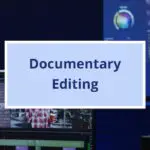Have you ever wondered why filmmakers use clapper boards, and what exactly it’s for?
Let’s explore the fascinating history and importance of clapper boards in filmmaking, and how they help filmmakers create their artistic visions.
So, grab your popcorn and settle in for an illuminating read!
Definition of Clapper boards
Clapper boards, also known as clapboards or film slates, are devices used in filmmaking and video production to assist in synchronizing picture and sound.
They consist of a rectangular white board with a hinged top piece that opens and closes, producing a loud and sharp sound.
The clapperboard helps establish continuity and ensures accurate synchronization, which is crucial during the post-production editing process.
Over time, the clapperboard has evolved, and modern clapperboards can display information digitally, making them even more useful in the filmmaking process.
Importance of Clapper boards in Filmmaking
Clapperboards are an essential tool in the filmmaking process, assisting with synchronization of picture and sound.
They ensure accurate synchronization, help in post-production editing, and establish continuity.
Clapperboards have been used in filmmaking since the earliest days, and have evolved from manual versions to digital clapperboards.
Their standardized form of displaying relevant information ensures that every shot and take is properly identified, making the job of the editor much easier.
The clapperboard remains a fundamental tool in modern cinema.
What is a Clapperboard?
A clapperboard is a device used in filmmaking and video production to assist in the synchronization of picture and sound. It is a rectangular white board with a hinged top piece that opens and closes creating a loud sharp sound when struck.
The purpose of the clapperboard is to ensure accurate synchronization, help in post-production editing, and establish continuity.
The use of clapperboards has evolved over time to include digital options, tail slates, and a guide to proper clapping techniques.
Clapperboards are essential tools for filmmakers to maintain consistency between shots and ensure that the final product is a seamless production.
Roles of Clapperboard in Filmmaking
Clapperboards play a crucial role in filmmaking as they assist in the synchronization of picture and sound. They also designate and mark various scenes and takes as they are captured and recorded.
Additionally, clapperboards help establish continuity, ensuring that segments of film and audio match with corresponding segments of sound. Overall, the use of clapperboards ensures accurate and seamless post-production editing.
How Clapperboard helps in Filmmaking process
Clapperboards are an essential tool in the filmmaking process, as they assist in ensuring accurate synchronization of sound and picture, help in post-production editing, and establish continuity. Without a clapperboard, filmmakers run the risk of having scenes and audio tracks out of sync, creating a disjointed final product.
Proper clapperboard techniques and following the guide to clap the board ensures that scenes and takes are properly marked and easily matched with corresponding segments of audio. Their importance in filmmaking cannot be overstated.
Ensures Accurate Synchronization
One of the main reasons filmmakers use clapperboards is to ensure accurate synchronization of audio and video. The clapper sound and scene details recorded on the slate section of the board serve as cues that the editor can easily match up during post-production editing.
This helps to save time and ensure that the final product has a seamless audiovisual experience. No wonder clapperboards are considered indispensable on film and video sets!
Essential for Editing by the Post-Production Team
Using the clapperboard helps in post-production editing by providing accurate and synchronized information for the editor to work with.
By using the clapperboards to mark the different scenes and takes during filming, the editor is able to easily match up specific audio and visual segments, making the editing process much smoother and more efficient. This helps to ensure that the final product is of the best possible quality.
Clapperboard Establishes Continuity
Clapperboards play a crucial role in establishing continuity in filmmaking. By accurately marking the scenes and takes, clapperboards ensure that each shot is consistent and can be easily identified later in the editing process. This helps filmmakers maintain a cohesive narrative and create a polished final product.
Without clapperboards, it would be much more challenging to keep track of which takes correspond to which scenes, leading to confusion and errors in post-production editing.
Using a Clapperboard
A video from the CASTALDO ACADEMY on YouTube:
The Clapperboard Explained — How to Use a Film Slate
Key Points from the Video:
Topic: Introduction
– The video is about how to use a slate in film production.- Knowing when to come into the scene to mark the slate is the first step, followed by listening for the first ad or director to call out your name.- Once you step in front of the camera with the slate, hold it up and say, “Scene ten Alpha, take one. Mark it.”- Marking a slate is easy once you know when and how to do it.
Topic: What is a Slate?
– The slate is a basic tool used on any film set.- It has a white balance bar, production name, role, scene and take number, director’s name, camera/DP’s name, date, and other details related to production.- The slate is used to help filmmakers keep track of various details and maintain consistency in production.- Code names are used for different letters to avoid confusion between letters and numbers.- A is referred to as Alpha, B as Bravo, and C as Charlie.
Topic: Soft Sticks
– Soft sticks are used during close up or emotional scenes to avoid disturbing the actor’s performance.- They are called softly and used especially when the slate is close to the actor’s face.
Topic: Tail Slating
– Tail slating will be the next topic of discussion.- When the director calls cut, yell out Tail slate to keep recording.- Hop into the camera frame, ensure focus, flip board upside down and say mark, mentioning scene number and take number.
Topic: MoS
– MoS means no audio for a scene.- Use a slate to indicate MoS by circling it and holding the slate with hands between the clapper.- For the first camera or Camera A, make sure the slate is in frame.- Mark the first camera with scene and take info, and for the other cameras, use Camera B mark or Camera C mark.- Role, scene, and take are three main things to know.- Role refers to the card number, and multiple cards might be used during an extended shoot, so it’s important to write them down.
Topic: Conclusion
– Use Gaffers tape to cover main areas that won’t change during the production and write down those areas to ensure they don’t change.
A. Evolution of Clapperboards
Clapperboards have been a crucial part of filmmaking since the earliest days of the craft. The device aided in the synchronization of picture and sound and helped to designate and mark various scenes and takes.
The device has evolved over the years, from early slate boards, to wooden clapperboards, to digital clapperboards that can change and display all relevant information digitally.
Despite the rise of technology, clapperboards remain a critical tool for filmmakers to ensure accurate synchronization, help in post-production editing, and establish continuity in their projects.
B. Contribution of Clapperboard in Modern Cinema
Even in today’s digital age, the clapperboard remains an essential tool in modern cinema and video production. Digital clapperboards can now display information electronically and can even sync with the camera’s internal clock.
However, the basic function of the clapperboard remains the same: to synchronize picture and sound and mark each take accurately.
Using a clapperboard can save valuable time in post-production editing and ensures continuity in a film’s storyline.
A. Manual Clapperboards
Manual clapperboards are an indispensable tool for filmmakers and have been used since the early days of cinema.
They consist of a wooden or plastic slate with hinged clapper sticks attached to it.
The clapper sticks are snapped together to create a visual and audible cue for later synchronization in post-production.
They provide accuracy and continuity to the filmmaking process, allowing for easier editing and post-production. As technology advances, manual clapperboards remain an essential part of a film production team’s toolkit.
Correctly Marking the Clapperboard
Correctly marking the clapperboard is crucial to ensure accurate synchronization of audio and video during post-production. Each space on the film clapper corresponds to the script supervisor’s report, so it’s important to check with him or her before marking any space.
The information on the slate, such as roll number and take number, is used for organizing footage.
Always mark the slate for A camera for consistency’s sake, and consider marking the audio file if you won’t have dailies.
Following proper clapperboard techniques can make post-production process smoother and more efficient.
B. Digital Clapperboards
In modern filmmaking, digital clapperboards have become more common. These clapperboards include an electronic box that displays timecode information continuously on a LED display.
The timecode displayed on the clapperboard is synced with the internal clock of the camera, making it easier for the film editor to pull timecode metadata from the video and audio files and synchronize them.
However, even with electronic timecodes, the traditional clapper sticks are still closed together manually to ensure there is a way of manually synchronizing the footage and audio if matching the digital timecode fails.
Tail Slate
Tail slate is a technique where a clapperboard is used at the end of a take instead of the beginning.
This method is not as common and is usually reserved for situations when the actors need to focus on their performance or when the camera movement or focus cannot be adjusted to capture the slate at the beginning.
In modern filmmaking, digital clapperboards can be used to change and display all relevant information digitally, making it easier for post-production editing.
A. Guide to Clap the Board
To properly clap the board, the clapperboard operator must present it in clear view and focus for a moment or two before striking the sticks.
The sound should be loud and sharp to ensure accurate synchronization.
When using a clapperboard, it’s important to keep track of scenes and takes to establish continuity.
By following proper clapperboard techniques, filmmakers can ensure a smooth post-production phase and make editing and organizing footage more manageable.
Keeping track of scenes and takes
Keeping track of scenes and takes is crucial in filmmaking, which is why clapperboards are often used on set.
With the help of a clapperboard, the production team can easily identify and sort through different takes, even those without sound. Properly marking the clapperboard can also establish continuity and help in post-production editing, ultimately resulting in a smoother and more efficient workflow.
B. Benefits of following proper Clapperboard techniques
Following proper clapperboard techniques is crucial in filmmaking as it ensures accurate synchronization between audio and visual elements, helps in post-production editing, and establishes continuity.
By using clapperboards correctly, the production team can avoid time-consuming reshoots caused by syncing errors or continuity issues. It also helps the editor to easily identify which clip matches which sound in the post-production stage. Proper clapperboard techniques can save time and money, making it an essential tool in any filmmaker’s kit.
Buying A Clapperboard
When it comes to buying clapperboards, it’s important to consider the needs of your production and the specific features that will be most useful to you.
Traditional manual clapperboards are still widely used and can be purchased in various sizes and materials.
However, digital clapperboards offer additional benefits such as timecode generation and easy access to metadata information.
Ultimately, choosing the right clapperboard will depend on your specific filmmaking style and the needs of your production.
So, Why Do Filmmakers Use Clapper Boards?
Clapperboards have been an essential tool in filmmaking since the early days of the craft.
They help to synchronize picture and sound, establish continuity, and aid in post-production editing. Their iconic nature also adds a sense of legitimacy to any production.
While digital alternatives are available, clapperboards remain a dependable source of information and a helpful reminder to the importance of every shot.
For filmmakers, having a clapperboard on set is a must-have tool.
More about Filmmaking
- Low Budget Filmmaking: More for Less
- Lighting Department Film Roles
- Shooting An Interview
- Documentary Editing
- What is Sound Design in Film?
- Color Grading for Documentary Series or Film
- Film Set Etiquette: Professional Behaviour on Set
- Observational Documentaries And Their Impact
- Essential Skills for Film Industry Professionals
- How to Create a Storyboard in 6 Simple Steps
- What Makes a Film Successful
- Breaking into the Film Industry without Experience
- Sports Documentary Filmmaking
- How to Create a Storyboard Using Sticky Notes
- Remove Background Noise From Video
- Why Do Filmmakers Use Clapper Boards?
- Indie Films
- Indie Filmmaking
- What is Post Production in Film
- Ken Burns Effect: Creating Eye-Catching Sequences






















